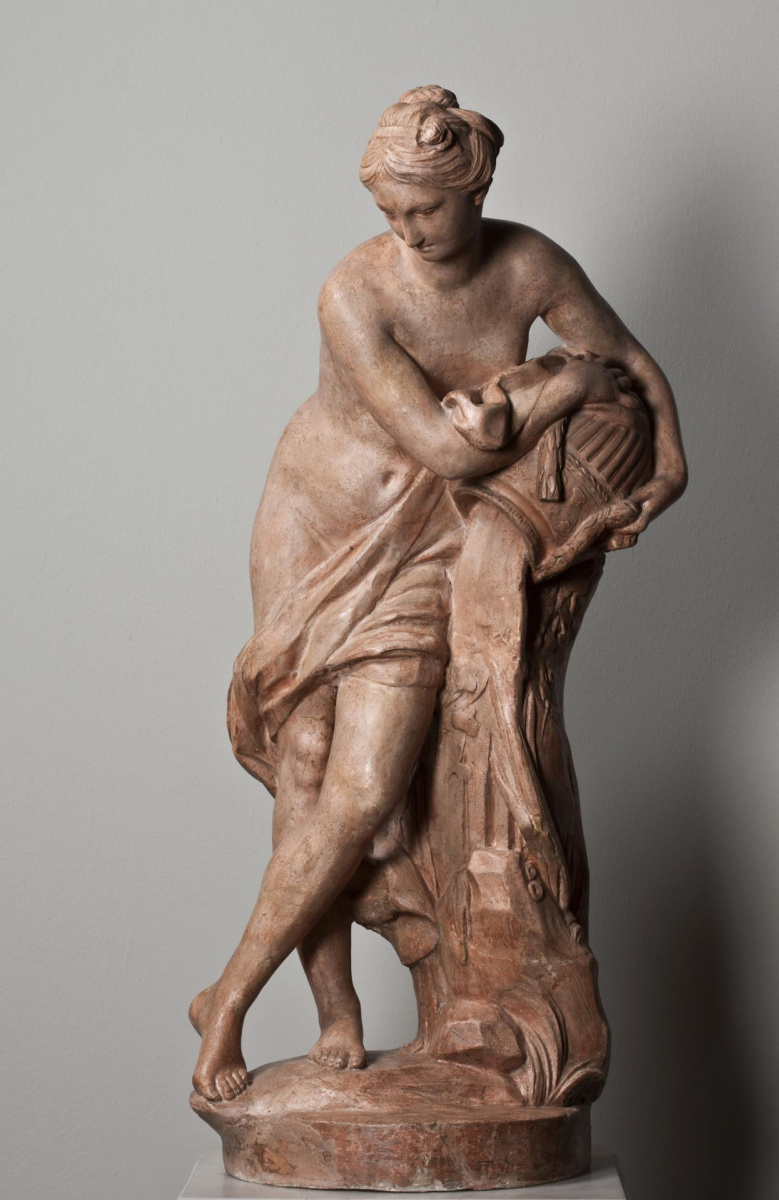Nymph of a Spring
Description of the artwork «Nymph of a Spring»
The Nymph of a Spring by Étienne Maurice Falconet has a rather intricate and complex fate as for such a small and chamber work. Now it is on view at the State Hermitage in Russia, and its place of birth is France.
Falconet finished the 82 cm high plaster figure only in 1757, ten years before he was invited to Russia to create a monument to Peter I (“The Bronze Horseman”). Young Falconet worked on sculptures in the Church of St. Roch at that time, and at the same time, he was in charge of the sculpture workshop of the Sevres porcelain manufactory. There, under the auspices of the all-powerful Madame Pompadour, Falconet created small graceful sculptures that aroused pure delight among the French public. According to those who knew it well, Falconet had a special gift of noble simplicity. In his performance, grace remained grace, without turning into pretentiousness. His miniature sculptures, bathers, nymphs, flora, were perfect.
Falconet decided to present two of his most successful sculptures, The Threatening Cupid and Nymph at the Bath, at the Salon of 1757. Everything went well. Critics greeted the Cupid with praise and enthusiasm, the reviews of the Nymph were also favourable. In his essay for La Correspondance Littéraire magazine, Denis Diderot stated: “The nymph is the embodiment of youth, purity and feminine charm.”
Diderot and Falcone became friends. They often argued, but their views on the structure of the state largely coincided. In particular, both of them were impressed by the figure of the Russian Emperor Peter. The French considered him a revolutionary transformer of the bone and rough matter of Russian statehood.
Once, during a small dinner party at the Diderot house, the fate of Étienne Maurice Falcone took an unexpected turn. The Russian ambassador Golitsyn, who was present there, said that he was looking for a performer for the statue of Peter, which Catherine II had conceived to erect in memory of the emperor in the new capital he had created. According to legend, the master of graceful figurines, who secretly cherished the dream of creating something truly monumental some day for many years, came into violent excitement and right on the corner of the dining table, on a snow-white tablecloth, depicted a horse galloping and a horseman holding it back over a steep abyss. And Diderot said to Golitsyn: here is your artist, what a coincidence!
Of course, it looks more like a legend. Most likely, even before that memorable dinner, Diderot had recommended Falconet to Catherine II in his personal correspondence. However, be that as it may, Falconet was getting ready to go to Russia. Firstly, he decided to send several of his sculptures by sea so that they could be presented to the Empress, the Academy of Arts or someone important and influential.
On 25 August 1766, the L'Aventurier ship sailed from the French coast. The destination of the voyage stated St. Petersburg. In the hold of the ship, along with the works purchased by Golitsyn for the imperial collection, were three original Falconet plaster casts: The Bather, Milo of Croton and Nymph of a Spring.
The travel turned out to be difficult. The sculptures suffered from the sea water, and the Nymph of a Spring also crashed. And he felt doubly hurt, because Falconet multiply repeated other two sculptures in marble, even in bronze, but he still did not get around with the Nymph. Although it was obviously dear to its author, it remained in the form of a plaster model, in a single copy.
“Falconet himself restored this original plaster in Russia,” wrote Zinaida Zaretskaya, an art historian. “Numerous seams are visible on the surface. The traditional allegorical figure of the river deity with an urn from which water flows, was transformed by the hand of a talented sculptor into a feminine image enchanting with its grace and spontaneity.”
In 1926, the Nymph of a Spring was moved from the Museum of the Academy of Arts to the State Hermitage collection.
Anna Vcherashniaya


